The Trinity House helicopter hovers dramatically alongside Longships lighthouse during a storm. On its helideck is a rubber water bag that has been delivered by the helicopter.
(MBB)
The Trinity House helicopter hovers dramatically alongside Longships lighthouse during a storm. On its helideck is a rubber water bag that has been delivered by the helicopter.
(MBB)
THERE CAN be no doubt that there will never be another rock light constructed around the British coastline of a similar design to such legendary giants as Bishop Rock, Eddystone, Bell Rock or Skerryvore. The days when men like the Stevensons, the Douglass’s or James Walker could make their reputation and fortune by designing and building lighthouses on some of the most exposed sites in the world have gone. The few lighthouses that have been constructed since the middle of this century are the product of relatively anonymous engineers, built of modern materials to modern designs, and full of technology that was designed to make the job of a lightkeeper unnecessary.
The rock lighthouses that appear in this book mark a particular era in civil engineering achievement that has now passed. The newest rock lighthouses, which in themselves are rare phenomena, are designed to be totally automatic in operation and functional in design – no longer is a new lighthouse considered a thing of grace and beauty. It is also sad to relate that even the old masonry towers have changed as part of their conversion to automatic working. For some of the towers the first feature to go was their graceful symmetry – changed forever by the addition of a helideck above the lantern which shrouded the sparkling glassware inside the lantern behind a latticework of steel. This was followed by the less obvious changes to internal equipment and illuminating devices.
The ‘Golden Age’ of British lighthouse construction spanned the century between roughly 1790 and 1890. This was a period when most of the worst reefs, promontories and islands received a lighthouse, nearly all of which survive to this present day. Prior to this time was the period of innovation when engineers were tentatively placing their structures of various designs and efficiency upon rocks previously thought an impossible site for any kind of permanent construction. Henry Winstanley had put two towers on the Eddystone followed by Rudyerd’s wooden light before John Smeaton finally led the way for modern lighthouse design with his cylindrical stone pillar. Let us not forget also that Henry Whiteside had placed a wooden, open-piled lighthouse on the Smalls before 1790, in a design that has been copied throughout the world in certain situations.
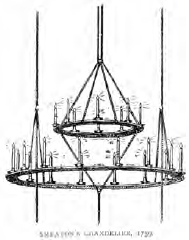
Early illuminants for rock lighthouses were usually tallow candles carried in a chandelier. This illustration shows the 24 candles that were used in Smeaton’s Eddystone of 1759.
(The Strand Magazine)
All of our present acclaimed rock towers are of post-1790 construction. Samuel Wyatt’s short, stumpy Longships tower marked the start of the great renaissance of lighthouse construction in 1795, followed by a remodelled Skerries light in 1804, Bell Rock in 1811, Longstone in 1826, Skerryvore in 1844, and the first stone tower on Bishop Rock in 1858. In quick succession these were followed by stone towers on the Smalls (1861), Wolf Rock (1870), Dubh Artach (1872), the second Longships tower (1873), Chicken Rock (1874), and the present towers of Eddystone (1882) and Bishop Rock (1887). Nearly 100 years of some of the finest civil engineering to be seen, yet so often never fully appreciated because of its remoteness. These were the years of Nicholas, James and William Douglass, of Robert, Alan, David and Thomas Stevenson, Joseph Nelson and James Walker – all brave and talented men who fought with nature, and won. They produced structures that are every bit as functional and every bit as sound today as when they were built, despite a constant assault by over a century of storms and revolutionary advances in technology. In the age of the micro chip we have yet to devise an adequate replacement for the lighthouse.
The period between the turn of the twentieth century until about the late 1960s/early 1970s saw progressive changes to the life and routine of a lighthouse keeper. While the structure in which he lived changed outwardly very little since it was built, the duties of a lightkeeper, the equipment in his charge, and his general day-to-day routine underwent considerable changes as the decades progressed. Originally, life for the keeper of a rock station was indeed a lonely and remote vigil in an outpost of the British Isles. Confined to a stone tower with two or three other men, out of contact with his family and the mainland for weeks at a time, and only relieved when the weather was sufficiently calm to allow an open boat close to the tower. His only source of power would have been paraffin or colza oil, possibly coal for cooking, and his entertainment when off duty was purely what he brought with him or could devise himself. During the winter months a turn of duty could be prolonged by many weeks by the weather, with all the attendant boredom and frustration that meant.
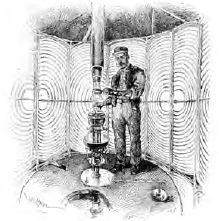
Later improvements in illumination were brought about by the Argand lamp which had a wick burning colza oil enclosed in a glass tube. One of Eddystone’s keepers is seen here lighting the Argand lamp around which the glass prisms revolved.
(The Strand Magazine)
By the end of the 1970s such an existence had, by and large, disappeared. Since then, the day-to-day existence for a keeper at a rock station was pretty well as it would be at a shore station, apart for the absence of his family. Huge diesel oil generators provided the electricity for power and light, including the high-wattage electric bulbs in the lantern that replaced the paraffin and acetylene burners. Electricity within the tower meant that television and radio, plus the convenience of modern appliances such as fridges and freezers were all available to the lightkeeper, as well as instant communication with the mainland by VHF radio and UHF telephone if necessary. Internal fitments and fittings were all upgraded so that life in a modern British rock station was altogether a more civilised existence than it used to be.
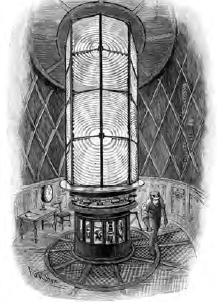
The glass prisms in a lantern were originally made to revolve by clockwork, which required their mechanism to be wound up at regular intervals. One of the Eddystone keepers is seen here winding up the weight that ran down a hollow metal tube through the centre of the rooms below the lantern.
(The Strand Magazine)
But, there was one particular aspect of life in a rock light that changed out of all recognition within the final years of manned operation – the method of relieving the keepers. One of the greatest hardships of a posting to a rock station was the uncertainty of relief, for it was only on a near perfect day that such a hazardous manoeuvre could be attempted at many of these stations. In most cases it involved navigating an open boat close enough to the base of the tower to allow a rope to be stretched between them. All men and supplies were then exchanged by being dangled from a pulley that ran along this rope. If the rope lost its taughtness, then whatever was travelling along it was in danger of being dumped into the confused waters below the tower. It was, by all accounts, an extremely nerve racking procedure for both those in the boat, who had to keep the craft at a constant distance from the tower in a not inconsiderable swell, and for the keepers who were being changed, although many regarded it as part and parcel of their life at a rock station. Some rock stations were on sufficiently large reefs to allow a boat to tie up at a jetty that had been constructed specifically for this purpose, in which case a relief became considerably less fraught.

The new lantern installed after the automation of Bell Rock is miniscule by comparison with some of the giants that used to be found inside a rock light lantern, although it is equally as reliable.
(Jim Bain)
Clearly, a situation where reliefs could be delayed for anything up to six weeks in the winter because of the sea was most unsatisfactory and could throw the relief schedules into chaos. In the early 1970s Trinity House and the Northern Lighthouse Board solved this problem by effecting reliefs by helicopter. Both Trinity House and the NLB hired Bolkow twin-engined helicopters which were used to relieve their remaining manned stations every 14 or 28 days, or deliver maintenance and engineering personnel to the unmanned towers. The helicopters set down, either on an area of reef adjacent to the tower, such as is the case at Longstone, Dubh Artach and Skerryvore, or on a specially constructed helideck, 30 ft in diameter, held above the lantern by an elaborate web of steel supports. As I have mentioned on more than one occasion, this ‘mortar board’ headgear does little to improve the appearance of the tower – many would argue the opposite – yet there can be little argument that this viewpoint is offset by the amount of time and expense saved in relieving the keepers on time or with only minimal delay. The first British lighthouse to have its keepers relieved by helicopter was Wolf Rock from its newly constructed helideck on 3rd November 1973, although a helicopter had been used to deliver overdue supplies to this station as early as 1948.
The advantages of such an operating procedure were enormous, and the conversion of all the major rock stations to facilitate helicopter reliefs was tackled with some urgency. All the famous English towers – Wolf Rock, Bishop Rock, Longships, the Smalls and Eddystone – were given helidecks in succession. Interestingly, there is no Scottish rock light with a helideck above its lantern, as all the Northern Lighthouse Board towers have room for a helicopter to set down beside the tower. At the Bell Rock, where the strata of the rock made it impossible, a special raised helipad was built on the reef itself to enable a helicopter visit that coincided with a low tide during daylight hours.
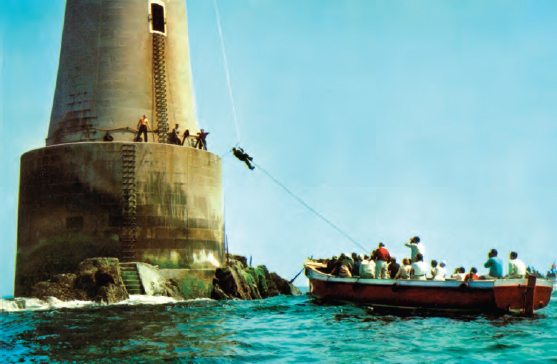
A Bishop Rock boat relief has been captured in this old postcard that shows how the keepers were transferred between an open boat and the set-off of the lighthouse. Most of the other boats in attendance are filled with tourists who came to watch the spectacle.
Up to three keepers could be exchanged on each relief, but only one or two was the usual practice, as well as about 270 kg of supplies and provisions. Reliefs were rarely delayed by more than 24 hours because of the weather, fog being the main culprit in this respect, and they have still continued in force ten winds. Each helicopter has instrumentation to allow it to fly in poor visibility or at night. The keepers were flown from one of the land bases around the British Isles where their homes were normally situated. In addition to carrying crew, the helicopters are also used to carry personnel from the engineering departments to and from the lighthouses with equipment and materials. An underslung cargo hook is fitted to each helicopter. In conjunction with this, the two Trinity House vessels – THV Patricia and THV Mermaid – as well as the NLB tenders MV Pharos and MV Pole Star have a helideck constructed above their own decks to allow helicopters to pick up personnel, fuel, water and building materials.
A sequence of photographs showing a typical Wolf Rock boat relief in the 1920s before it had a helideck. Communication with the lighthouse as to whether a relief was going to be attempted was all done by semaphore flags from the Trinity House tender.
(Syndication International)
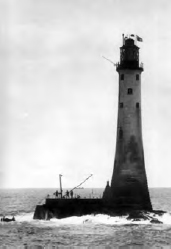
The transfer from open boat onto the landing stage was done by a metal derrick pole which can be seen in action here. On the very left is the small boat waiting to receive or discharge the keepers.
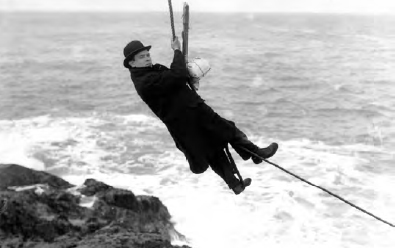
Mr F. G. Few seems to be taking his relief from Wolf Rock in March 1923 all in his stride. He has dressed in overcoat and bowler hat for the occasion and still smokes a cigarette as he is lowered into a waiting boat, clutching what is probably his fishing rod. (Syndication International)
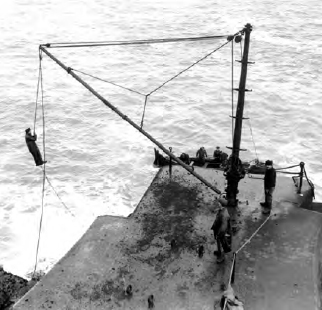
A view of the transfer procedure from the tower itself. Boiler ash is spread on the landing stage to enable the workers to keep their footing on what could be a trecherous surface.
(Syndication International)
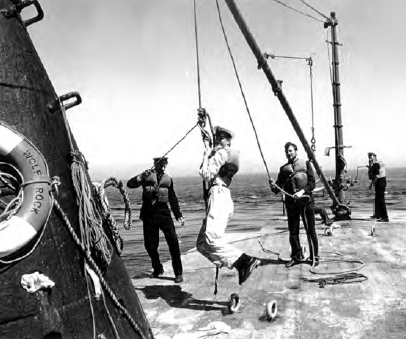
A ship’s officer from the Trinity House tender is brought onto Wolf Rock in Septmber 1972. The triangular metal beacon built into the landing stage is on the left of the picture carrying a Wolf Rock lifebuoy.
(ALK archives)
A rare photograph showing that helicopters were being used by Trinity House long before any of their towers had helidecks. The Dragonfly helicopter is picking up emergency supplies for Wolf Rock lighthouse from Penzance pier in February 1948. The keepers were many weeks overdue for relief because of unsuitable sea conditions.
(Walter Boyd)
Another trend common to both lighthouse authorities that had started well before the 1970s was automation. In fact the process started in the 1920s – long before silicon chips were dreamt of. It was a policy dictated to a large extent by simple economics and advancing technology. To any lighthouse service the more keepers it employs the more it is going to cost to run that service, and every day’s delay in relieving those men is a further expense. Both the Northern Lighthouse Board and Trinity House followed a policy in the last twenty years of the twentieth century to convert all of their isolated and remote stations, followed by all their shore stations, to automatic operation.
From a purely financial and cost-efficiency standpoint, it makes absolute sense to install equipment whose operation can be made automatic and monitor it from a shore station via VHF radio or telemetry. Trinity House and the NLB cannot be criticised for pursuing such a policy, yet a consequence of its adoption was, of course, the elimination of the need for any keepers to be relieved at all – only regular maintenance visits, which might only take a few hours every six months, being required at each station.
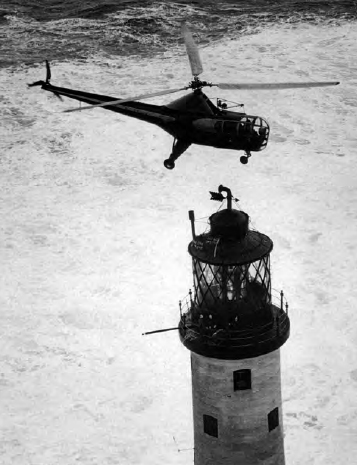
The same helicopter hovering over Wolf Rock ready to lower the emergency supplies. The three keepers can all be seen on the lantern gallery.
(Daily Graphic)
The first automatic lighthouses were powered by acetylene gas under pressure which illuminated a gas mantle and turned the revolving lantern at the same time. A regular programme of replenishment of the acetylene cylinders was still needed, but thanks to a clever device known as a ‘sun valve’ the supply of acetylene was cut off during hours of daylight making it function like a traditional lighthouse – but without the expense of keepers. Chicken Rock lighthouse was converted to automatic operation in this manner after the fire of 1960.
When the first edition of this book was published in 1983, the automation process of rock lighthouses had only just begun in earnest with the automation of the Eddystone in 1982. By the end of 1998 it was complete – there wasn’t a single manned Trinity House shore station or rock lighthouse. It was much the same picture with the NLB who had retired all of their keepers by March of the same year. All of this has been possible due to rapid technological advances over the past few decades.
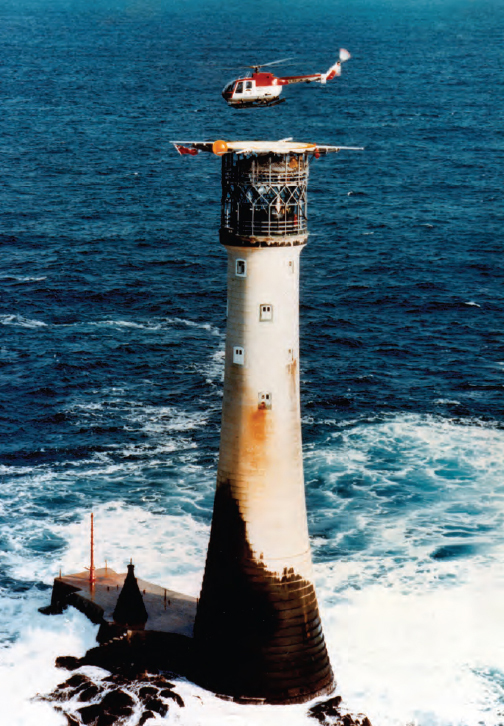
The Trinity House helicopter lifts off from Wolf Rock lighthouse after changing the keepers.
(MBB)
Despite all this, as I have already said, in the age of the silicon chip we have yet to find an adequate replacement for a lighthouse. What the microchip has done though is to be a more than adequate replacement for the lighthouse keeper. Equipment controlled by microprocessors that requires maintenance only twice a year instead of twice a day doesn’t need the constant supervision and attention of a keeper. The main reason for a keeper to be at a lighthouse has therefore disappeared. Of course, the keepers provided other ‘unofficial’ services such as giving assistance to the RNLI or HM Coastguard when vessels got into trouble, or keeping weather records for the Meteorological Office – services which although not in their ‘official’ job descriptions, all keepers did willingly. The thousands of yachtsmen who spend their weekends and holidays sailing around our coasts will perhaps feel that little bit less secure when they realise that the lighthouses they pass no longer contain any human observers to keep an eye on their progress – just in case the unexpected should happen.
What of the future? We are undoubtedly in a new era for the British lighthouse service. An era that, even without keepers, sees our two lighthouse authorities continue to improve the service they give and reduce the costs of providing that service. Currently, top of the lighthouse authority efficiency agenda is the process of solarisation – the conversion of lighthouses to make use of environmentally friendly – and free – solar power, rather than the costly, difficult to transport, awkward to store and potentially hazardous diesel oil. Development of high efficiency metal halide bulbs has allowed the replacement of the gas mantle and traditional lighthouse ‘bulb’ by solar-electric systems which charge the internal batteries by generating an electric current directly from sunlight. In fact, not even direct sunlight is required – something that can be in short supply in the north of Scotland during winter. The solar panels can make use of diffused light through cloud cover, and the batteries are of a sufficient number and size to accumulate enough energy in the summer and autumn months to ensure it can be stored for winter operation. Trinity House is now the largest user of solar power in the United Kingdom.
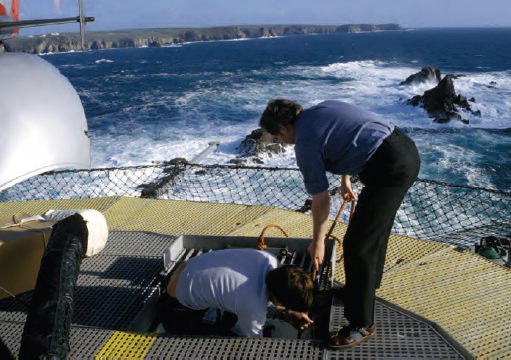
The Trinity House helicopter is sat on top of Longships lighthouse with its clam-shell doors open. Two of the keepers are busy lowering supplies through the trapdoor to the lantern gallery below.
(Author)
Part of the automation process can often involve reducing the range of the navigation light or altering its character. Modern commercial shipping equipped with satellite navigation and radar doesn’t need a lighthouse to flash a warning that extends for over 20 miles as it used to do. The amount of power required for the reduced light range of, typically, 18 miles has decreased in the last decade from over 100 watts to 35 watts by making use of the new generation of high-efficiency and low-energy lamps operating directly from a 24-volt battery supply. Supplementary power for monitoring purposes can also be supplied from small wind-powered generators – and wind is something the north of Scotland has plenty of during winter!
Recent additions to many of the rock lights in this volume have been banks of solar panels in an appropriate location, out of reach of the waves. Usually, on the towers, the only place for them is attached to the outside of the lantern balcony. Eddystone, Wolf Rock and Hanois lighthouses have impressive rings of panels circling their helideck supports. At the same time as the solar panels were being added, many of the towers were losing their fog warning devices. In January 2005, the three General Lighthouse Authorities of the UK and Ireland issued a consultation document following a joint review of Aids to Navigation of the coasts of the United Kingdom and Ireland. Part of this document reviewed the need for the provision of fog horns. The conclusion was that audible fog signals had a significantly reduced role in the modern marine environment, as a result of the widespread use of electronic position-finding aids and radar, and the adoption of enclosed bridges on many vessels. There are now no Scottish lighthouses with a fog horn – the last to lose its ‘voice’ was Skerryvore in October 2005.

Looking up from the lantern gallery of the Smalls lighthouse at a keeper on the helideck lowering his belongings through the trapdoor.
(Author)
So, the particular era of achievement that produced the rock lighthouse, with its own special ethos, has gone forever. Part of the fascination and appeal of these structures was knowing that they were inhabited by men whose job was to be locked in the forefront of the struggle between man and the elements. A lifeless stone pillar, its insides packed with sophisticated electronic gear and monitoring devices, its exterior bristling with antennae, beacons and solar panels does not hold the same fascination. Perhaps the saddest result of automation is that without men living in the same quarters, using the same stairs, attending the same lantern, and looking across the same waters as their forerunners did over decades past, the stories of the raising of granite pillars out of foaming seas with all the human dramas that have taken place during and since that time, may slip quietly into oblivion.
The electronic sophistication of the ‘Met’ room in Bell Rock lighthouse with Principal Keeper John Boath (left) and Assistant Keeper Ernie England. The room is packed with all manner of warning, recording and communications equipment – as well as an exercise bike ! Note that there is still a telescope hanging from the ceiling.
(Jim Bain)
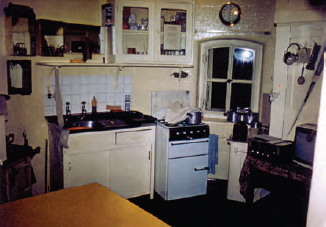
A 1980s view of the ‘modernised’ Eddystone kitchen on the 6th floor.
(ALK archives)
A lighthouse without keepers becomes simply an impassive stone monument. When the interest of the local community ceases to focus upon that monument, as it surely has when the regular change of keepers ceases, when families cease to keep an extra special eye on the weather on relief days, or when the uncertainty of knowing whether their loved ones will be home for Christmas is gone, then its very existence very quickly fades from the memory, particularly if its remoteness also places it out of sight. It was the keepers who related the stories of the lighthouse, tales which had been passed down from previous keepers, tales of shipwreck and storm, so that such stories were perpetuated and kept within the memory – but only so long as the keepers remained within the tower. Now the day has come when there is no such person as a lighthouse keeper I fear the lighthouses themselves may become just maritime curiosities to future generations. It is partly because of such a fear that this volume has been produced.
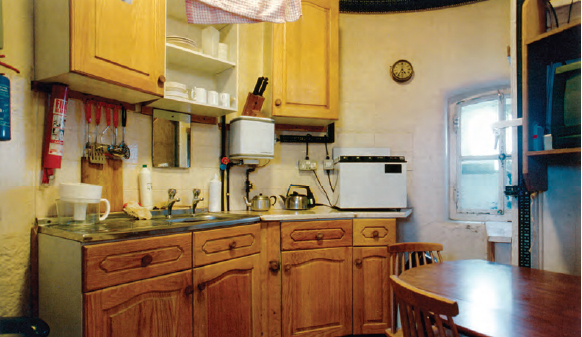
All the comforts of home? Quality fixtures and fittings inside the kitchen of Wolf Rock lighthouse in October 1993 after it was automated.
(Andreas Koellner & Claudia Beurer)
The specially built helipad on the reef at Bell Rock meant keepers could be changed and equipment delivered without undue delay – providing it wasn’t foggy or high tide of course. The NLB helicopter drops onto the helipad in ideal conditions.
(Jim Bain)
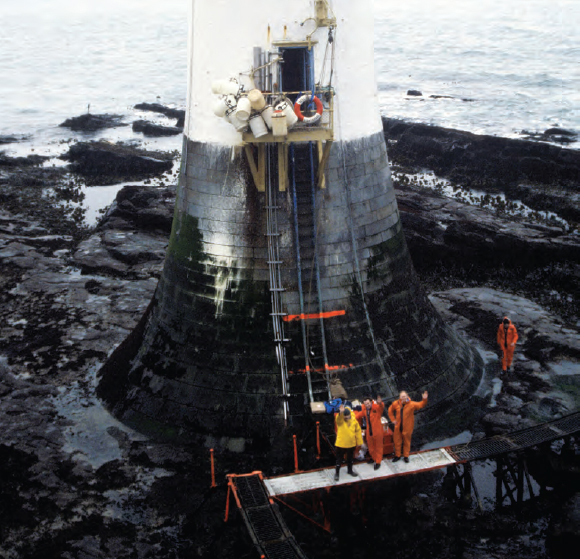
The keepers that have just been delivered to the Bell Rock lighthouse wave farewell to the NLB helicopter as it departs. They will be on duty here for the next month before it returns to take them ashore.
(Author)